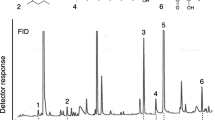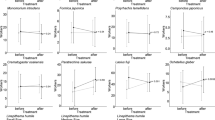Abstract
Contrary to previous assumptions,Daceton armigerum, the largest ant in the myrmicine tribe Dacetini, employs trail communication. We identified two anatomical sources of trail pheromones: Trails drawn with poison gland contents can last for more than seven days. Trails drawn with the newly discovered sternal glands (in the VIth and VIIth abdominal sternites) are effective but relatively short-lived. In addition, our bioassays revealed that the contents of the mandibular glands elicit alarm behavior, and secretions from the pygidial gland release attraction. When tested with artificial poison gland trails from seven other myrmicine species,Daceton did not exhibit trail following behavior. We confirmed, however, previous findings thatAtta respond toDaceton poison gland trails andSolenopsis followDaceton Dufour's gland trails.
Similar content being viewed by others
References
Attygalle, A.B. andMorgan, E.D. 1985. Ant trail pheromones.Adv. Insect Physiol. 18:1–30.
Bhatkar, A.P., andWhitcomb, W.H. 1970. Artificial diet for rearing various species of ants.Fla. Entomol. 53:229–232.
Blum, M.S., andPortocarrero, C.A. 1966. Chemical releasers of social behavior, X: An attine trail substance in the venom of non-trail laying myrmicine,Daceton armigerum (Latreille).Psyche 73:150–155.
Brown, W.L., andWilson, E.O. 1959. The evolution of the dacetine ants.Q. Rev. Biol. 34:278–294.
Burns, W., andBretschneider, A. 1981. Thin is In. American Society of Clinical Pathologists, Educational Products Division, Chicago, pp. 19–20.
Carlin, N.F. 1981. Polymorphisms and division of labor in the dacetine antOrectognathus versicolor (Hymenoptera: Formicidae).Psyche 88:231–244.
Dejean, A. 1980a. Le comportement de predation deSerrastruma serrula Santschi (Formicidae, Myrmicinae), I: Capacite de detection des ouvrieres, analyse des phase comportementales.Ann. Sci. Nat., Zool., 13(2): 131–143.
Dejean, A. 1980b. Le comportement de predation deSerrastruma serrula Santschi (Formicidae, Myrmicinae), II: Analyse sequentielle.Ann. Sci. Nat., Zool. 13(2): 145–150.
Dejean, A. 1985a. Etude eco-ethologique de la predation chez les fourmis du genreSmithistruma (Formicidae-Myrmicinae-Dacetini), II: Attraction des proies principales (Collemboles).Insect. Soc. 32:158–172.
Dejean, A. 1985b. Microevolution du comportamente de capture des proies chez les dacetines de la sous-tribu des Strumigeniti (Hymenoptera, Formicidae, Myrmicinae).Actes Colloq. Insect. Soc. 2:239–247.
Hölldobler, B. 1981. Trail communication in the dacitine antOrectognathus versicolor (Hymenoptera: Formicidae).Psyche 88:245–257.
Hölldobler, B., andEngel, H. 1978. Tergal and sternal glands in ants.Psyche 85:285–230.
Hölldobler, B., andWilson, E.O. 1990. The Ants. Harvard University Press, Cambridge. In press.
Jessen, K., Maschwitz, U., andHahn, M. 1979. Neue Abdominaldrüssen bei Ameisen, I: Ponerini (Formicidae: Ponerinae.Zoomorphologie 94:49–66.
Mascorro, J.,Ladd, M.W., andYates, R.D. 1976. Rapid infiltration of biological tissues utilizingn-hexanyl succinic anhydride (HSXA) vinyl cyclohexene dioxide (VCD), an ultra-low viscosity embedding medium. 34th Annual Proceedings of the Electron Microscopy Society of America, p. 346.
Masuko, K. 1984. Studies on the predatory biology of Oriental dacetine ants (Hymenoptera: Formicidae), I: Some Japanese species ofStrumigynes, Pentastruma, andEpitritus, and a MalaysianLabidogenys, with special reference to hunting tactics in short mandibulate forms.Insect. Soc. 31:429–451.
Morgan, E.D. 1984. Chemical words and phrases in the language of pheromones for foraging and recruitment, pp. 169–194,in T. Lewis (ed.). Insect Communication (Symposium of the Royal Entomological Society of London, No. 12) Academic Press, London.
Oliveira, L., Burns, A., Bisalputra, T., andYang, K. 1983. The use of an ultra-low viscosity medium (VCD/HXSA) in the rapid embedding of plant cells for electron microscopy.J. Microsc. 132:195–202.
Tumlinson, J.H., Silverstein, R.M., Moser, J.C., Brownlee, R.G., andRuth, J.M. 1971. Identification of the trail pheromone of a leaf-cutting antAtta texana.Nature 234:348–349.
Tumlinson, J.H., Moser, J.C., Silverstein, R.M., Brownlee, R.G., andRuth, J.M. 1972. A volatile trail pheromone of the leaf-cutting ant,Atta texana.J. Insect Physiol. 18:809–814.
Vander Meer, R.K. 1986. The trail pheromone complex ofSolenopsis invicta andSolenopsis richteri, pp. 201–210,in C.S. Lofgren and R.K. Vander Meer (eds.). Fire Ants and Leaf-Cutting Ants: Biology and Management. Westview Press, Boulder, Colorado.
Wilson, E.O. 1962. Behavior ofDaceton armigerum (Latreille), with a classification of self-grooming movements in ants.Bull. Mus. Comp. Zool. 127:401–422.
Wilson, E.O. 1971. The Insect Societies. Belknap Press of Harvard University Press, Cambridge. x+548 pp.
Author information
Authors and Affiliations
Rights and permissions
About this article
Cite this article
Hölldobler, B., Palmer, J.M. & Moffett, M.W. Chemical communication in the dacetine antDaceton armigerum (Hymenoptera: Formicidae). J Chem Ecol 16, 1207–1219 (1990). https://doi.org/10.1007/BF01021020
Received:
Accepted:
Issue Date:
DOI: https://doi.org/10.1007/BF01021020




